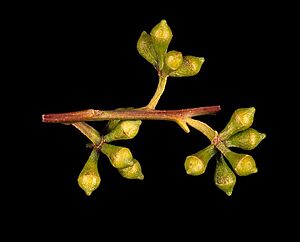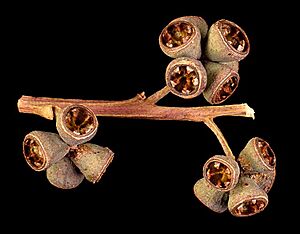Rose gum facts for kids
Quick facts for kids Rose gum |
|
|---|---|
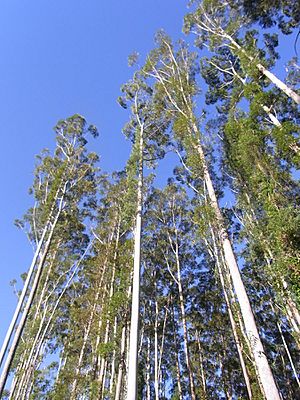 |
|
| Eucalyptus grandis at Kerewong State Forest, Australia | |
| Scientific classification | |
| Genus: |
Eucalyptus
|
| Species: |
grandis
|
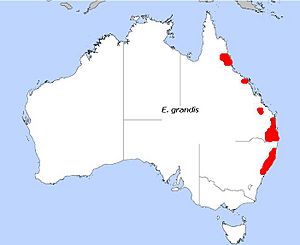 |
|
| Eucalyptus grandis, field distribution | |
The Eucalyptus grandis, often called the flooded gum or rose gum, is a very tall tree. It has smooth bark that is usually pale grey or white. Near the bottom of its trunk, the bark can be rough and brownish. This amazing tree can grow up to 50 metres (160 feet) (about 164 feet) tall. Some of the biggest ones can even reach over 80 metres (260 feet) (262 feet)!
You can find the rose gum along the coast and in areas near the coast in Australia. It grows from Newcastle in New South Wales all the way north to west of Daintree in Queensland. These trees mostly live on flat land and gentle slopes. They are a main tree in wet forests and at the edges of rainforests.

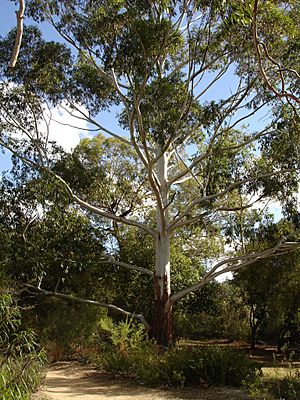
Contents
What Does the Rose Gum Look Like?
The Eucalyptus grandis is a very straight and tall forest tree. It usually grows to about 50 m (160 ft) (164 feet) high. The main part of its trunk, called the bole, stays straight for most of the tree's height.
Size and Bark
The biggest rose gum trees can reach 75 m (246 ft) (246 feet) tall. One famous tree, known as "The Grandis" near Bulahdelah, is 86 m (282 ft) (282 feet) high! The bark on most of the tree is smooth and powdery. It can be pale grey, blue-grey, or white. However, the bottom 1 to 4 meters (3 to 13 feet) of the trunk have rough, brownish bark. This rough bark looks like a "skirt" around the base of the tree.
Leaves and Flowers
The leaves of the rose gum are glossy and dark green. They are shaped like a spear, about 10 to 16 cm (3.9 to 6.3 in) (4 to 6 inches) long and 2–3 cm (0.79–1.18 in) (0.8 to 1.2 inches) wide. The underside of the leaves is a lighter color. You can find tiny oil glands all over the leaves.
The tree's flower buds grow in groups of seven, nine, or eleven. They are oval or pear-shaped and can be green, yellow, or a bit waxy-looking. White flowers bloom from mid-autumn to late winter, usually from April to August. After the flowers, the tree produces fruit that looks like a cone or pear. These fruits are about 4 to 10 millimetres (0.16 to 0.39 in) (0.16 to 0.4 inches) long.
Similar Trees
The rose gum looks a lot like the Sydney blue gum (E. saligna). However, the Sydney blue gum has narrower leaves. Its gumnuts (fruits) are more bell-shaped with parts that stick out. Another similar tree is the mountain blue gum (E. deanei). You can tell it apart because its bark is completely smooth, and its adult leaves are wider.
How the Rose Gum Got Its Name
The Eucalyptus grandis was first officially described by a person named Walter Hill in 1862. The name grandis means "large" in Latin. This name was chosen because the tree grows to such a huge size. People commonly call it the flooded gum or the rose gum. In Queensland, it is mostly known as the rose gum.
Where the Rose Gum Lives
The E. grandis tree grows in coastal areas and nearby ranges. You can find it from Newcastle in New South Wales up to Bundaberg in central Queensland. There are also smaller groups of these trees further north near Mackay, Townsville, and Daintree in northern Queensland.
These trees prefer deep, rich soils found on flat land and lower slopes. They need a lot of rain, from 1100 to 3500 millimeters (43 to 138 inches) per year. The rose gum is a dominant tree in wet forests and at the edges of rainforests. It can grow by itself or mixed with other trees like blackbutt, tallowwood, and Sydney blue gum.
The rose gum has also been planted in other countries, like Uruguay. There, it is sold under the name "Red Grandis."
Uses of the Rose Gum Tree
The flooded gum is a very popular tree outside of Australia because of its straight trunk and useful wood. It is grown in large plantations in places like South Africa and Brazil. In Australia, there are plantations in northern New South Wales. Young trees there can grow as much as 7 metres (23 feet) (23 feet) in their first year!
Timber and Wood Products
The wood from the rose gum has a pretty pink color. It is used for many things, such as:
- Making furniture and joinery
- Flooring
- Building boats
- Wall panels
- Plywood
The wood has a straight grain, meaning the wood fibers run in a straight line. It is also quite strong and lasts a reasonable amount of time. It is resistant to certain beetles called Lyctus borers, which can damage wood.
Other Uses
- Fighting Salinity: Sometimes, rose gums are mixed with river red gum (Eucalyptus camaldulensis) to help fight salinity in the soil. Salinity is when there is too much salt in the soil, which can harm plants.
- Insect Food: Eucalyptus grandis is a food source for some insects, like paropsine beetles and Christmas beetles. Christmas beetles can sometimes eat so many leaves that they defoliate, or strip the leaves from, trees on Australia's east coast. To protect plantations, scientists have bred special rose gum trees that these beetles don't like to eat as much.
- Bee Forage: In South Africa, rose gum plantations are very important for beekeepers. When the trees flower, many bee colonies move into these areas. The flowers have a strong scent, and bees can travel far to find them.
- Landscaping: While too big for most home gardens, the rose gum makes a beautiful tree for large parks and farms. It can also help stabilize riverbanks, preventing erosion.
Pulpwood
The wood from rose gum trees is also used to make pulp. This pulp is then used to create paper and other paper products.
See also
 In Spanish: Eucalipto rosado para niños
In Spanish: Eucalipto rosado para niños


